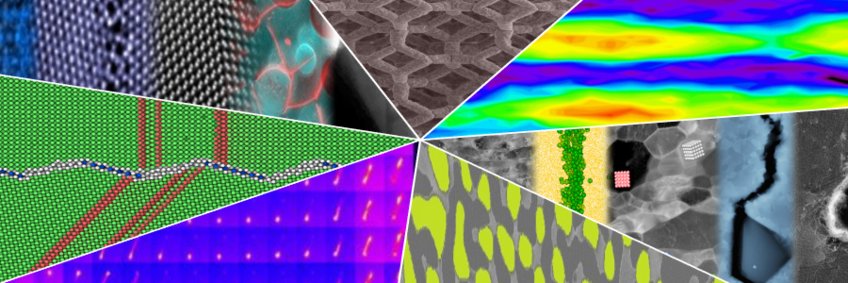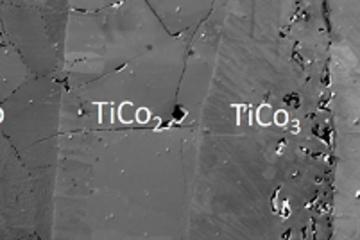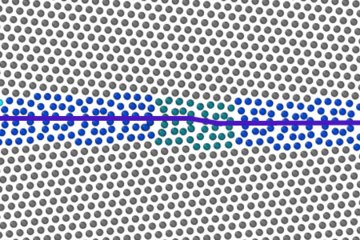
Correlating the State and Properties of Grain Boundaries
This project with the acronym GB-CORRELATE is supported by an Advanced Grant for Gerhard Dehm by the European Research Council (ERC) and started in August 2018.
The project GB-CORRELATE explores the presence and consequences of grain boundary phase transitions (often termed “complexions” in literature) in pure and alloyed Cu and Al. If grain size gets smaller and smaller - like in nanocrystalline materials - the grain boundary (GB) volume can exceed several 10% of the total material volume and become a powerful lever to manipulate and set properties. The atomic coordination and chemistry of such GBs may undergo phase transitions, abrupt changes in structure and/or chemistry, which will impact the material behavior - like strength, thermal stability, electrical resistance – even for conventional materials. However, this interplay between GB phases and material properties is poorly understood. Experimentally, GBs are difficult to study - it needs atomic resolution and sensitivity with respect to chemistry to uncover their structure and possible complexions. In addition, it is unknown under which conditions phase transformations of GBs occur. A fundamental understanding requires atomistic modelling connected with smart experiments.
One of our approaches is to grow Cu and Al films on (0001) oriented α-Al2O3 substrates, which leads to a strong (111) texture with several symmetric and asymmetric tilt GBs [1]. Using Cu thin films we could demonstrate that a pure elemental metal which forms only a single bulk fcc phase as a solid can form several GB phases [1,2]. We observed at a ∑19b [111] tilt GB 3 different atomic motifs (phases) for different grain boundary inclinations. At asymmetric ∑19b [111] and symmetric ∑19b [111] (178) GB we found the coexistence of two grain boundary phases [2] separated by a line defect (see Fig.1). This was experimentally observed for the first time and predicted before in literature to be very rare. We could, however, reveal in recent studies that in pure Cu complexions are not rare, but also occur at other tilt grain boundaries, see [3] for a recent publication. The coexistence of the two GB phases (see e.g. Fig. 1) indicates a sluggish transition, which was supported by atomistic modelling. Extensive molecular dynamics simulations by our cooperation partner T. Frolov revealed that for the ∑19b [111] tilt grain boundary shear stresses drive the phase transformation rather than temperature [2]. This is opposite to other ∑ [111] tilt GBs in Cu and Al, where indeed temperature triggers the GB phase transformation [3].
![Fig.1 Scanning transmission electron microscopy high-angle annular dark-field image of an asymmetric ∑19b [111] tilt GB in Cu consisting of pearl and domino structure separated by a disconnection (line defect). See [2] for further details.](/4706780/original-1643792313.jpg?t=eyJ3aWR0aCI6MTM3OCwib2JqX2lkIjo0NzA2NzgwfQ%3D%3D--56d0a203061bc0058e48acedcacfad3a6d1b756e)
We also alloyed the ∑19b GB with Zr and Ta [1]. While Ta and Zr are known to be hardly soluble in Cu and thus have a high driving force for grain boundary segregation only Zr leads to a GB decoration preferentially at steps, while Ta forms precipitates at the GB due to kinetic reasons. Furthermore, Zr induces GB disorder and structural transitions, lowering the GB free energy. As a consequence, the driving force for GB migration is lowered and the microstructure is stabilized. The difference in atomic grain boundary structure for Ta and Zr is described in full detail in [1].
As another processing route for dedicated Cu bicrystal experiments, we grew asymmetric ∑5 [001] bicrystals by the Bridgman method [4]. After Ag segregation, the overall macroscopic grain boundary observed at low magnification in scanning transmission electron microscopy (STEM) appearedAg curved. A closer inspection by STEM reveals that the GB leaves its original asymmetric inclination and adopts a nanofaceted state containing Ag-rich, symmetric ∑5 (210) segments and asymmetric Ag-lean ∑5 segments. Exceeding a threshold amount of solute excess, the boundary undergoes a first order transition and becomes nanofaceted. The symmetric ∑5 (210) segment increases in length with Ag coverage and become dominant at high Ag contents above a full monolayer coverage (Fig. 2). The results are summarized in a GB faceting diagram (Fig. 2) [4].
![Fig.2 GB faceting diagram presenting the facet segment length evolution along the Cu(Ag) ∑5 [001] GB as a function of Ag solute excess concentration. Three distinct GB states appear: (i) asymmetric and not faceted for low Ag excess, (ii) nanofaceted, preferentially segregated boundary within a solute excess window and (iii) symmetric and not faceted boundary for high Ag excess. From [4]](/4706869/original-1643792313.jpg?t=eyJ3aWR0aCI6MTM3OCwib2JqX2lkIjo0NzA2ODY5fQ%3D%3D--278387dec1bb8dc962cad4502ee3d36eecf85648)
We also made a big leap forward in obtaining electrical properties from individual GBs. We developed a detailed methodology to probe in situ or ex situ the local resistivity of individual GBs [5]. For in situ measurements, electrical contacts were realized with W needles accurately positioned by piezo driven micromanipulators. Fig. 3 shows our set-up applied to study the change in resistance across a Cu Σ3 [111] (112) tilt GB.
As a next step we analysed also Σ7, Σ19b, Σ21a, and Σ37c and low angle Cu GBs with misorientation angles ranging from 7° to 18°(Fig. 4). The GB resistivity is correlated with the boundary’s excess volume and excess energy in first approximation. The resistivity values of low angle GBs with misorientations of more than 10° are the highest among the tilt GBs, due to the high dislocation density and the resulting strain fields. GB curvature increases resistivity of the boundary due to deviation from tilt condition. Our work [6] provides a systematic experimental study on the impact of GB structure on its electrical properties.
![Fig.3 Four point in situ resistance measurement of a GB. Scanning electron microscopy and diffraction is used to determine the GB character and position. A clear resistance signal is obtained for the incoherent ∑3 [111] (211) GBs (red and blue data points). From [5].](/4706936/original-1643792313.jpg?t=eyJ3aWR0aCI6MTM3OCwib2JqX2lkIjo0NzA2OTM2fQ%3D%3D--a327058644f119215e139cb8780ae0503fb984fa)
![Fig. 4. GB resistivity values of different coincidence site lattice (CSL) GBs and low angle GBs. The colored regions represent the spread of the measured values. In the vertical direction, they include the resistance measurement deviation obtained from all measurements within the same CSL type (including different GB structural characteristics). In the horizontal direction, they represent the angular tolerance of CSL type set by the Brandon criterion. The dashed line indicates the average value of resistivity for each CSL type. The resistivity of a 7° LAGB (marked with an arrow) is below the sensitivity of the measurement method. From [6].](/4706981/original-1643792313.jpg?t=eyJ3aWR0aCI6MTM3OCwib2JqX2lkIjo0NzA2OTgxfQ%3D%3D--118c3408012d300a8d55bb93e63a18f34c4b237b)
We currently work on the impact of complexions on shear coupled GB motion, dislocation –transmission across GBs, GB strength and fracture. Some recent results can be found in [7-9].
![Fig.1 Scanning transmission electron microscopy high-angle annular dark-field image of an asymmetric ∑19b [111] tilt GB in Cu consisting of pearl and domino structure separated by a disconnection (line defect). See [2] for further details. Fig.1 Scanning transmission electron microscopy high-angle annular dark-field image of an asymmetric ∑19b [111] tilt GB in Cu consisting of pearl and domino structure separated by a disconnection (line defect). See [2] for further details.](/4706780/original-1643792313.jpg?t=eyJ3aWR0aCI6ODQ4LCJmaWxlX2V4dGVuc2lvbiI6ImpwZyIsIm9ial9pZCI6NDcwNjc4MH0%3D--3407fd4bf8051bf13296348e6e5df04c098f52f7)
![Fig.2 GB faceting diagram presenting the facet segment length evolution along the Cu(Ag) ∑5 [001] GB as a function of Ag solute excess concentration. Three distinct GB states appear: (i) asymmetric and not faceted for low Ag excess, (ii) nanofaceted, preferentially segregated boundary within a solute excess window and (iii) symmetric and not faceted boundary for high Ag excess. From [4] Fig.2 GB faceting diagram presenting the facet segment length evolution along the Cu(Ag) ∑5 [001] GB as a function of Ag solute excess concentration. Three distinct GB states appear: (i) asymmetric and not faceted for low Ag excess, (ii) nanofaceted, preferentially segregated boundary within a solute excess window and (iii) symmetric and not faceted boundary for high Ag excess. From [4]](/4706869/original-1643792313.jpg?t=eyJ3aWR0aCI6ODQ4LCJmaWxlX2V4dGVuc2lvbiI6ImpwZyIsIm9ial9pZCI6NDcwNjg2OX0%3D--d0b986774ada7fa84483a9e4a849b1410af8f372)
![Fig.3 Four point in situ resistance measurement of a GB. Scanning electron microscopy and diffraction is used to determine the GB character and position. A clear resistance signal is obtained for the incoherent ∑3 [111] (211) GBs (red and blue data points). From [5]. Fig.3 Four point in situ resistance measurement of a GB. Scanning electron microscopy and diffraction is used to determine the GB character and position. A clear resistance signal is obtained for the incoherent ∑3 [111] (211) GBs (red and blue data points). From [5].](/4706936/original-1643792313.jpg?t=eyJ3aWR0aCI6ODQ4LCJmaWxlX2V4dGVuc2lvbiI6ImpwZyIsIm9ial9pZCI6NDcwNjkzNn0%3D--e261ee2d0533f04e3673208dbc40b3a52e17ad56)
![Fig. 4. GB resistivity values of different coincidence site lattice (CSL) GBs and low angle GBs. The colored regions represent the spread of the measured values. In the vertical direction, they include the resistance measurement deviation obtained from all measurements within the same CSL type (including different GB structural characteristics). In the horizontal direction, they represent the angular tolerance of CSL type set by the Brandon criterion. The dashed line indicates the average value of resistivity for each CSL type. The resistivity of a 7° LAGB (marked with an arrow) is below the sensitivity of the measurement method. From [6]. Fig. 4. GB resistivity values of different coincidence site lattice (CSL) GBs and low angle GBs. The colored regions represent the spread of the measured values. In the vertical direction, they include the resistance measurement deviation obtained from all measurements within the same CSL type (including different GB structural characteristics). In the horizontal direction, they represent the angular tolerance of CSL type set by the Brandon criterion. The dashed line indicates the average value of resistivity for each CSL type. The resistivity of a 7° LAGB (marked with an arrow) is below the sensitivity of the measurement method. From [6].](/4706981/original-1643792313.jpg?t=eyJ3aWR0aCI6ODQ4LCJmaWxlX2V4dGVuc2lvbiI6ImpwZyIsIm9ial9pZCI6NDcwNjk4MX0%3D--0ab44b0c5d5784b28041e556c7dab32dc48e3825)











